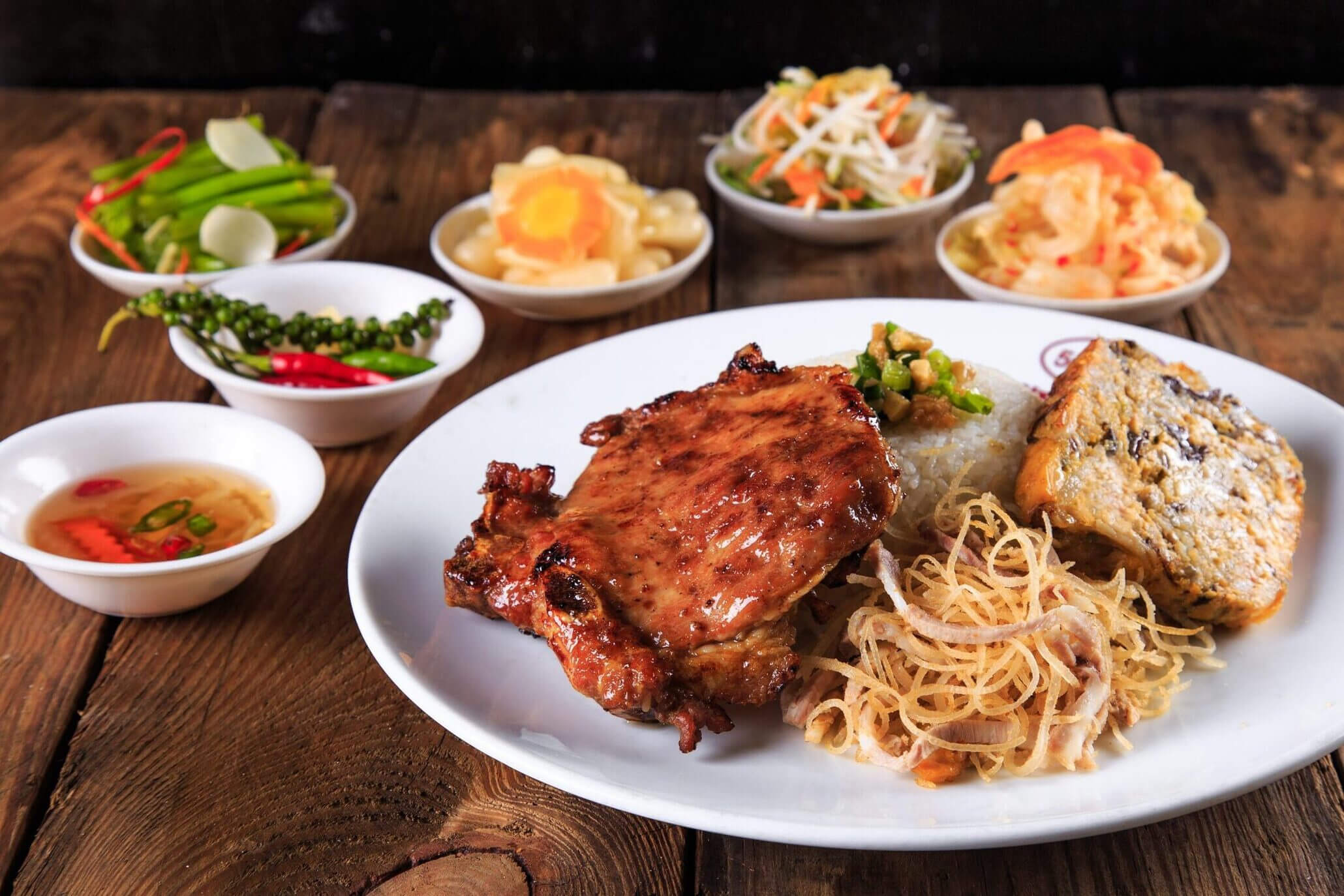Exploring the Com Tam: Delicacy Vietnamese Culinary Gem
In the vibrant tapestry of Vietnamese cuisine, Com Tam stands out as a beloved dish cherished for its rich flavors, diverse textures, and cultural significance. As a staple of street food stalls and local eateries across Vietnam, Com Tam offers a tantalizing blend of ingredients that reflect the country’s culinary heritage and regional diversity. Let’s delve into the intricacies of this delectable dish and uncover the secrets behind its enduring popularity.

Com Tam
Origins and Evolution
Com Tam, which translates to “broken rice” in Vietnamese, has humble origins that trace back to the rice fields of southern Vietnam. Historically, broken rice grains were considered inferior and unsuitable for export, leading farmers to repurpose them for local consumption. Over time, ComTam evolved from a frugal peasant dish into a beloved street food specialty enjoyed by people from all walks of life.
Key Ingredients and Flavor Profile
At the heart of Com Tam is fragrant broken rice, characterized by its slightly chewy texture and nutty flavor. The dish is typically accompanied by a diverse array of toppings, including grilled pork chops (suon nuong), shredded pork skin (bi), steamed pork and egg cake (cha trung hap), and a crispy pork sausage (cha), each adding its own unique flavor and texture to the ensemble.
Serving and Presentation
What sets Com Tam apart is not only its distinctive flavors but also its artful presentation. The dish is traditionally served on a plate lined with a bed of warm broken rice, topped with slices of grilled pork chops and garnished with a colorful array of accompaniments. A side of sweet and tangy fish sauce (nuoc cham) is drizzled over the rice, infusing every bite with a burst of flavor and complexity.
Regional Variations and Specialties
While Com Tam is widely enjoyed throughout Vietnam, each region has its own unique take on the dish, incorporating local ingredients and culinary traditions. In Ho Chi Minh City, the birthplace of Com Tam, street vendors offer a plethora of variations, from succulent grilled prawns to savory grilled chicken. In central Vietnam, ComTam may feature grilled beef or fish, reflecting the region’s coastal influence and abundance of seafood.

Com Tam
Cultural Significance and Culinary Heritage
Beyond its culinary appeal, Com Tam holds cultural significance as a symbol of resilience, resourcefulness, and community. As a dish born from humble origins, it embodies the spirit of innovation and adaptability that is inherent in Vietnamese cuisine. Whether enjoyed as a quick street food snack or as a comforting home-cooked meal, ComTam brings people together, forging connections and fostering a sense of shared identity.
Com Tam stands as a testament to the rich tapestry of Vietnamese cuisine, showcasing the ingenuity, diversity, and culinary prowess of the country’s culinary heritage. With its tantalizing flavors, artful presentation, and cultural significance, Com Tam continues to captivate the palates and imaginations of food enthusiasts around the world, inviting them on a culinary journey that celebrates tradition, innovation, and the joy of sharing a delicious meal with loved ones.
Exploring the Pros and Cons of Com Tam: A Vietnamese Culinary Delight
Com Tam, a beloved Vietnamese dish featuring broken yowestogel login rice served with a variety of flavorful toppings, has gained popularity both locally and internationally for its rich taste and cultural significance. While Com Tam boasts numerous advantages that contribute to its appeal, it also presents certain drawbacks that merit consideration. Let’s delve into the strengths and weaknesses of this iconic dish.

Com Tam
Advantages Com Tam
- Rich Flavor Profile: One of the primary advantages of ComTam is its rich and diverse flavor profile. The combination of fragrant broken rice, savory grilled meats, and tangy fish sauce creates a harmonious blend of sweet, savory, and umami flavors that tantalize the taste buds and leave diners craving for more.
- Cultural Heritage: ComTam carries significant cultural and historical significance in Vietnam, representing the ingenuity and resourcefulness of the Vietnamese people. As a dish that originated from humble beginnings, Com Tam embodies the spirit of resilience and adaptation that is inherent in Vietnamese cuisine, making it a symbol of cultural pride and identity.
- Versatility: Com Tam offers versatility in both its preparation and presentation, allowing for a wide range of variations and customization options. From the choice of meats and toppings to the accompaniments and condiments, ComTam can be tailored to suit individual preferences and dietary restrictions, making it accessible to a diverse range of tastes and preferences.
Disadvantages Com Tam
- Nutritional Considerations: While Com Tam is undeniably delicious, it may not always align with dietary guidelines for optimal health. The dish is often high in calories, fat, and sodium, particularly when served with fatty meats and rich sauces. For individuals seeking to maintain a balanced diet or manage health conditions such as hypertension or obesity, Com Tam may need to be enjoyed in moderation.
- Hygiene Concerns: In some cases, the hygiene and food safety standards of establishments serving ComTam may be subpar, posing potential risks to consumer health. Street vendors and small eateries, while popular for their authentic flavors, may not always adhere to strict sanitation practices, increasing the risk of foodborne illnesses and gastrointestinal issues.
- Environmental Impact: The production of ComTam and its ingredients, particularly meat, may have environmental implications, including deforestation, habitat loss, and greenhouse gas emissions. Livestock farming, a common source of protein in Com Tam, is associated with significant environmental degradation and contributes to climate change. As awareness of environmental sustainability grows, consumers may seek alternative protein sources or environmentally friendly dining options.
Conclusion Com Tam
Com Tam offers a delightful culinary experience that celebrates the rich flavors and cultural heritage of Vietnam. While it boasts numerous advantages, including its rich flavor profile, cultural significance, and versatility, it also presents certain drawbacks, such as nutritional considerations, hygiene concerns, and environmental impact. By weighing these pros and cons, diners can make informed choices about when and how to enjoy this iconic Vietnamese dish, while chefs and food establishments can strive to maintain high standards of quality, safety, and sustainability in its preparation and presentation.
Read More Article About “Baltimore Bridge: Iconic Landmark and Vital Transportation Link“













